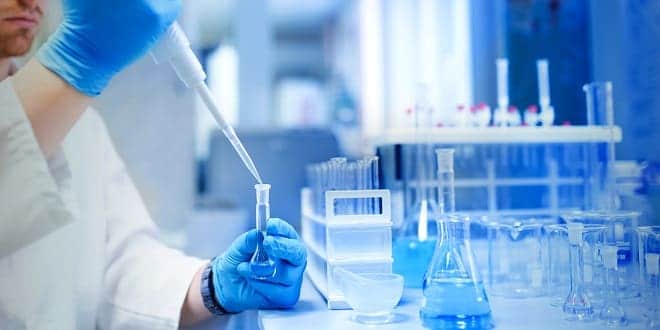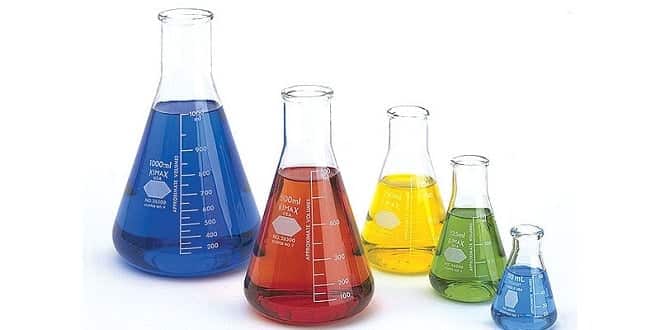pH | Defined Since concentrated acids have [ H+] equal to about 10M, very dilute acids have [ H+] of about .00001M, and strong bases, about .000000000000001 M, we have a very wide range of numbers. Such numbers are difficult to work with and almost impossible to graph. Any graph that would show the point .000000000000001 would not be able to represent the number 10 on the same planet. If each 1E-15 represented 1 mm on a number line, then the number 10 would be .1E16 mm away. This is a distance of 621,000,000 miles. number | log(number) | 10 | 1 | 1 | 0 | 0.1 | -1 | 0.01 | -2 | .001 | -3 | E-10 | -10 | In order to simplify dealing with such a large range of numbers, we use an exponential scale based upon logarithms. In general, the log 10x = x. From this equation, the table to the left may be generated. Notice, however, that most of the [ H+] will be negative. Only when [ H+] > 1M will the log be positive. Since we would prefer to work with positive numbers, pH has been defined as pH = – log [ H+] The effect of introducing the negative sign is that a high pH indicates a low degree of acidity. |
| Calculating pH 1. What is the pH of a solution with [ H+] = .010M?
(answer) pH = – log[ H+] = – log 1.0E-2 = – (-2.0) = 2.0
2. What is the pH of a solution with [ H+] = .050M?
(answer) pH = – log [ H+] = – log 5.0 E-2 = ……
Since .050 is between .010 and .10, the pH must be between 2 and 1.
Enter .050 into your calculator, then hit the log key, and retrieve an answer of -1.301
So then, pH = – log 5.0E-2 = – (-1.301) = 1.301
3. The pH of a solution is 3.301. What is the [ H+] ?
(answer) pH = – log [ H+] 3.301 = – log [ H+] log [ H+] = -3.301
Enter -3.301 into your calculator. (Sometimes you must enter 3.301, then +/-)
Then hit the 10x key. The answer is .00050 M |
pOH | pOH pOH = – log [OH–] We noted earlier that [H+] [OH–] = 1.0 E -14. We can then calculate the [OH–] from the [H+]. [H+] | [OH–] | pH | pOH | | 1.0E-7 | 1.0E-7 | 7 | 7 | in pure water | 1.0E-1 | 1.0E-13 | 1 | 13 | in .10M HCl | 1.0E-3 | 1.0E-11 | 3 | 11 | in .0010M HCl | 1.0E-13 | 1.0E-1 | 13 | 1 | in .10M NaOH | One consequence of H+] [OH–] = 1.0 E -14 is that pH + pOH = 14
This can be derived formally: | [H+] [OH–] = 1.0 E -14 | take the log of each side | log [H+] + log [OH–] = -14 | note that we used the concept, log(ab) = log a + log b | multiply each side by -1 | pH + pOH = 14 | |
| Some problems Determine the [H+], [OH–], pH and pOH for each of the following solutions (a) .0010M HBr, (b) .010M NaOH, (c) 1.0M HClO4, (d) 10M HCl, (e) 1.0M KOH | | [H+] | [OH–] | pH | pOH | a | .0010M HBr | .0010 | 1.0E-11 | 3 | 11 | b | .010M NaOH | 1.0E-12 | .010 | 12 | 2 | c | 1.0M HClO4 | 1.0 | 1.0E-14 | 0 | 14 | d | 10M HCl | 10 | 1.0E-15 | -1 | 15 | e | 1.0M KOH | 1.0E-14 | 1.0 | 14 | 0 | Note that the term in bold is the first term entered in each row. Some more problems: Determine the [H+], [OH–], pH and pOH for each of the following solutions
(a) .0040 M HCl, (b) 1.2M NaOH (c) pure water, (d) .00034M KOH | | [H+] | [OH–] | pH | pOH | a | .0040 M HCl | .0040 | 2.51E-12 | 2.40 | 11.60 | b | 1.2M NaOH | 8.34E-15 | 1.2 | 14.079 | -.079 | c | pure water | 1.00E-7 | 1.00E-7 | 7.00 | 7.00 | d | .00034M KOH | 2.95E-11 | 3.4E-4 | 10.53 | 3.47 | For example, (a) [H+] = .0040, -log (.0040) = 2.40,
.0040 x = 1E-14, x = 2.51E-12, -log (2.51E-12) = 11.6 |
N | Normality The normality of an acid is simply its [H+] . The normality of a base is its [OH–]. A 1 M NaOH solution is 1 N. A 1 M H2SO4 solution is more than 1 N but less than 2 N. This is because 1 mole of H2SO4 ionizes 100% to 1 M HSO4– and 1M H+ , but the resulting HSO4– is a weak acid which only partially ionizes to SO4-2 + H+. The normality would then be between 1 and 2 and depends upon the degree of ionization of HSO4–. Some questions which you should be able to figure out and explain:
1. Is the normality of a strong monoprotic acid equal to, less than, or greater than its molarity?
2. Is the normality of a strong polyprotic acid equal to, less than, or greater than its molarity?
3. Is the normality of a weak, monoprotic acid equal to, less than, or greater than its molarity?
Answers: (1) equal to (2) greater than (3) less than |
| Neutralization When an acid combines with a base, neutralization occurs. H+ from the acid combine with OH– of the base to produce water. If the number of H+ and OH– are equal, then complete neutralization occurs and the resulting solution has a pH = 7. A neutralization reaction has the form:
acid + base => salt + water
H2SO4 + NaOH => Na2SO4 + H2O |
| Titration In an acid-base titration, acid and base are combined in such a way that the end solution has a pH = 7. Solutions are added dropwise from burets until an indicator which changes color near pH=7 just undergoes a color change. If the normality of either the acid or base solution is known, then the normality of the other solution may be calculated, since the experimental results give the volumes of acid and base used. At pH = 7, (1) n(H+) = n(OH–)
Since NA = n(H+) / LA, then (2) n(H+) = NA LA
Similarly, NB = n(OH–) / LB and (3) n(OH–) = NBLB
Then it follows from (1) that (4) NALA = NBLB Since, in the titration experiment, LA and LB can be determined from the buret readings, if either NA or NB are known, the other may be calculated. In this way, we can use a titration to determine the strength of an unknown acid. We can multiply both sides of equation (4) by 1000mL/L to yield the more familiar form of the equation: (5) NA mLA = NB mLB A sample problem: If 10 mL of a 2.5 M HCl solution neutralizes 35 mL of an unknown NaOH solution, the N of the NaOH solution is calculated as follows: NA mLA = NB mLB
(2.5N)(10mL) = NB (35mL)
.71N = NB |


